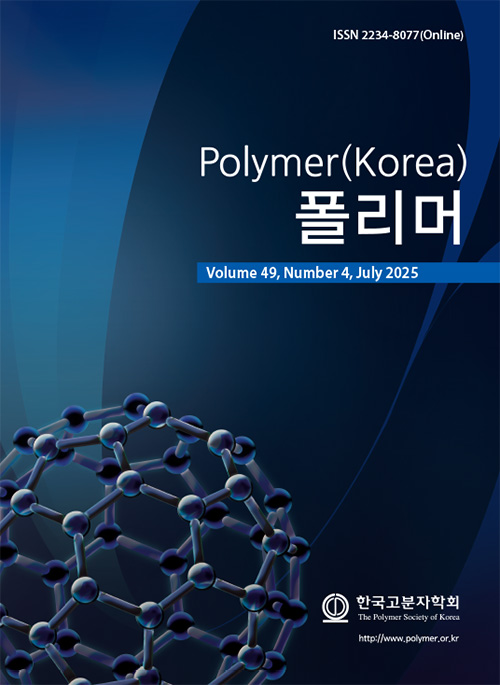- Flame Retardant (FR) and Antimicrobial Properties of Bifunctional Polyguanidine Salt Additives for Polypropylene (PP) Membrane Materials
Bowen Lv, Dongqing Liu†
 , Tian Xu, Yuxuan Cheng, Sun Zhou, Mengyuan Zhang, and Qinxing Xie
, Tian Xu, Yuxuan Cheng, Sun Zhou, Mengyuan Zhang, and Qinxing XieState Key Laboratory of Hollow Fiber Membrane Materials and Processes, Key Laboratory of Materials for Energy Storage, School of Material Science and Engineering, Tiangong University, Tianjin 300387, China
- Polypropylene(PP) 멤브레인 소재를 위한 이중 기능성 폴리구아니딘 염 첨가제의 난연 및 향균 특성 연구
Reproduction, stored in a retrieval system, or transmitted in any form of any part of this publication is permitted only by written permission from the Polymer Society of Korea.
Two polymeric additives, polyhexamethyl guanidine-diphenyl hypophosphite (DPPA-PHMG) and polyhexamethyl guanidine-chlorobridging acid (HA-PHMG), were prepared to overcome aqueous solubility of polyhexamethyl guanidine (PHMG) through salinization with two acidic flame retardant intermediates, diphenyl hypophosphite and chlorobridging acid. Melting points of two water-insoluble organic salts were 176.49 ℃ and 172.20 ℃ tested by TG, which were both higher than PHMG’s and brought better thermostability for the starting polymer. Their polypropylene (PP) blend films achieved 99.9% bactericidal rate for Escherichia coli and their suitable content improved flame-retardant performance in combustion experiments. PHMG serves as a useful platform for development of multifunctional additives.
Keywords: di-functional additives, bacteria inhibitor, flame retardant, polyhexamethyl guanidine salt.
- Polymer(Korea) 폴리머
- Frequency : Bimonthly(odd)
ISSN 2234-8077(Online)
Abbr. Polym. Korea - 2024 Impact Factor : 0.6
- Indexed in SCIE
 This Article
This Article
-
2025; 49(4): 411-416
Published online Jul 25, 2025
- 10.7317/pk.2025.49.4.411
- Received on Oct 31, 2024
- Revised on Jan 26, 2025
- Accepted on Feb 15, 2025
 Correspondence to
Correspondence to
- Bowen Lv, Dongqing Liu
-
State Key Laboratory of Hollow Fiber Membrane Materials and Processes, Key Laboratory of Materials for Energy Storage, School of Material Science and Engineering, Tiangong University, Tianjin 300387, China
- E-mail: ldqnov@163.com








 Copyright(c) The Polymer Society of Korea. All right reserved.
Copyright(c) The Polymer Society of Korea. All right reserved.